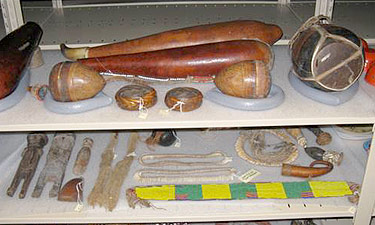The Save Our Hide Conservation Fund was established in 2008 to allow donations to be set aside to complete conservation work on important artifacts in the Museum’s collection. The Museum has identified more than 100 objects in its collection that are in need of professional preservation and conservation; however, this work is extremely expensive and often falls by the wayside due to financial constraints. Conservation efforts supported by this fund ensure that Lam Museum’s objects will survive to educate future generations.
Contributions to the Conservation Fund have been used to support the following projects:
- Conservation of a mid-19th century Comanche painted hide
- Conservation of a Yan ka di puppet, a ceremonial object from Mali
- Purchase of appropriate materials to create a state of the art storage environment for the entire collection
- Conservation of a pair of Barong Sai masks from Bali
- Conservation of a Pima ceramic cup
- Conservation of a Yoruba house of the head, or ile ori
- Conservation of a stone Coptic icon from Ethiopia
- Construction of a mezzanine level in our storage facility to provide the best care and storage of our collections
- Materials needed to move collections to new custom-designed storage space in the Museum’s new Palmer Hall location
- Conservation of a Kuba hat from the Democratic Republic of the Congo
- Conservation of a Yoruba shrine figure from Nigeria
- Conservation of a Bedouin wedding necklace from Saudi Arabia
- Conservation of a Baule fly whisk from the Ivory Coast

2025 Project
This year, we request your financial assistance to professionally conserve a group of six Chinese scrolls. The scrolls are among more than 100 objects in the Lam Museum collection acquired by Marion Dudley of Wilmington, NC, who served as a missionary with the YWCA in China between 1927 and 1947. The scrolls are frequently used to teach about Asian artistic traditions, visual storytelling, the history of missionaries, and relations between the United States and China. Recent student research confirmed that one of the scrolls contains two album leaves by well-known artist Ju Lian dating to 1873 and 1876. All six scrolls are very fragile, and it is increasingly difficult to use them in teaching without causing more damage. Conservation work must be done to stabilize and mount them, so they do not need to be rolled and unrolled, thus guaranteeing their long-term preservation. The help of supporters like you is essential to complete the conservation of these important artifacts.
Please contact Assistant Director Sara Cromwell at 336.758.5282 or lammuseum@wfu.edu to learn more. Donations to the Conservation Fund are fully tax-deductible.

